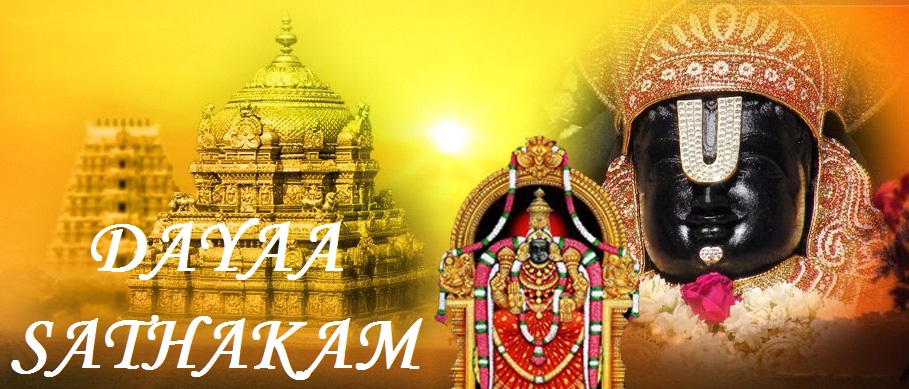This stotram celebrates the auspicious quality (Kalyana Guna) of Mercy (Dayaa) of the Lord of Thiruvenkatam. Of All the Kalyana Gunaas of Venkataadhri Sekhara Vibhu, His Dayaa is the most important one for the uplift of the Chetanaas. The concept of Prapatthi and Thiruvenkatamudayaan’s Dayaa to realize the fruits of that Prapatthi is the subject of Sri Venkatanatha Kavi in this “Satakam”.
The structure of this stotram containing 108 slokas (one for each of the Divya Desa Archaa Murthys of Sriman Narayana perhaps) is extraordinarily impressive even by Swami Desikan’s standards of poetic excellence. Our Acharya has used ten plus different meters to compose the ten groups of slokas, each of which houses “ ten” slokas. The numbers of slokas and their poetic meters are as follows:
1. Slokaas 1-10: Anushtup meter
2. Slokaas 11-20: Aryaa meter
3. Slokaas 21-30: Oupacchandhasikam
4. Slokaas 31-40: Maalini
5. Slokaas 41-50: Mandhaakraanthaa
6. Slokaas 51-60: Nathkutakam
7. Slokaas 61-70: SikariNi
8. Slokaas 71-80: HariNi
9. Slokaas 81-90: Pruthvee
10. Slokaas 91-104: Vasantha Tilakaa
11. Slokaas 105& 106: Maalini again
12. Slokaas 107& 108: Sardhoola Vikriditham
In the tradition of Sri Sriraama DesikAcchAr Swamy, each set of the ten slokas have the essence of the ten Patthus of Thiruvaimozhi of Nammazhwaar.
According to this tradition, every set of ten reveals a particular meaning, which together covers the Ananatha KalyaaNa GuNams of the Lord of Thiruvenkatam. The ten meanings associated with the ten sets of ten slokas have been summarized by Srirama Desikaacchaar Swamy this way:
1. The Lord of Thiruvenkatam is the one, who can give Mokshaanugraham.
2. He comprehends everything and He is capable of carrying out whatever He chooses to do.
3. He destroys the enemies of those, who surrender unto Him and thereby seek His help.
4. He is the means for attaining ALL worthwhile goals.
5. He is the fruit of ALL worthwhile endeavours.
6. He can be reached easily thru the glorious means of Prapatthi.
7. He will rush to the help of the lowest and the highest with same speed, when they appeal to Him sincerely for help.
8. He is the Supreme Principle standing on top of Thiruvenkatam.
9. He is the one, who took the incarnations of Rama and Krishna.
10. He is the one, who can offer the happiness associated with Moksha right here on this earth.
Swami Desikan goes on to describe in detail the Anantha Kalyana Gunaas of Sriman Narayana in his Taatparya RatnaavaLi and Dramidopanishad Saaram. He is thus paying his tribute to Nammazhwaar’s Thiruvaimozhi in all of these three works. We will illustrate the ten essential meanings of Daya Satakam in the subsequent sections as revealed by Srirama Desikaacchaar Swamy in the tradition of his Achaarya, Navaneetham Krishnamaacchaar Swamy of Oppiliappan Koil.

No comments:
Post a Comment